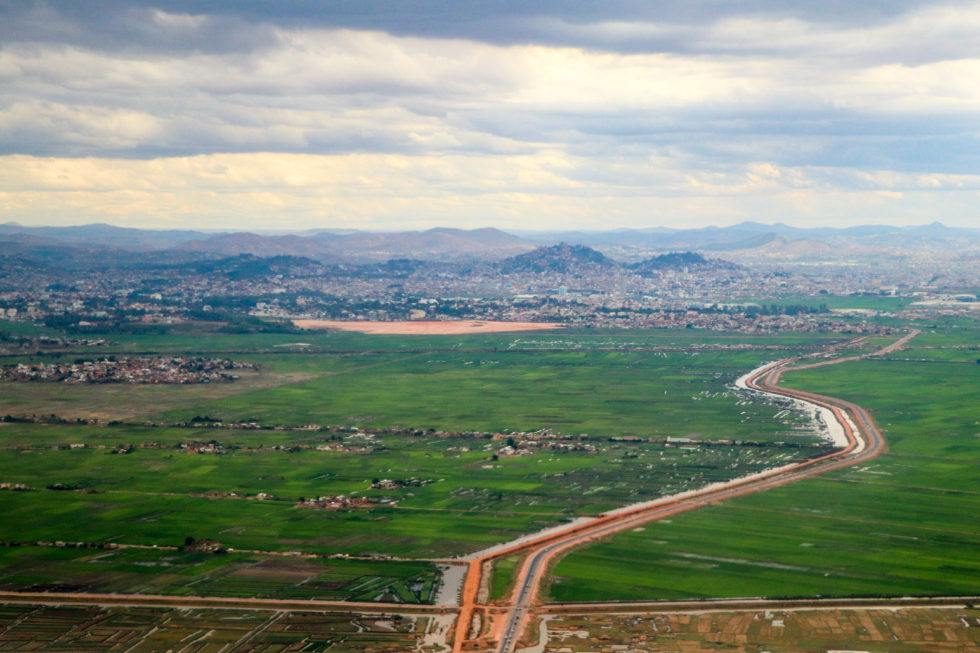12 February 2020
Unravelling the stories of our cities: Using urban metabolism to shape thriving African cities
Urban metabolism is an intuitive concept aimed at managing resource consumption and making cities more sustainable. The concept is most studied in the Global North, and there is little insight into how we implement urban metabolism principles in the Global South. Urban Intertwininga new ICLEI Africa project, intends to reframe the principles, tools and approaches of urban metabolism to be practical, tangible and applicable to cities on our continent. This will be achieved by embracing the decentralised, informal, fluid and interconnected nature of our resource systems to shape thriving, equitable African cities.



Our cities are made of flows. Flows of water, energy, food, materials, people, information, money and power. These flows – intertwined and woven into the urban fabric – give a city its unique character.
We can understand the interactions of these social and material flows as the city’s metabolism: a city takes resources from its local and global environments, consumes them, digests them and metabolises them – for economic growth, urban expansion, and social wellbeing – before it sends its waste back into the environment.

Once we understand how a city’s urban metabolism works, it is possible to reshape unsustainable flows to create more positive outcomes for urban businesses and citizens. This could mean making flows more equitable by ensuring the flow of resources to those that lack access or make use of low quality resources. It could mean making flows more efficient by using resources less or more productively, replacing fossil fuel flows with renewable energy sources, and reusing or recycling out-going flows to reduce our reliance on new resources from the environment. Turning waste flows into resources, by generating energy from landfill gas or by creating products out of used or discarded materials for example, enables circular development and improves resource productivity.
ICLEI’s Circular Development pathway promotes new principles of production and consumption, such as service or sharing economies, reuse, repair and refurbishment, designing for quality, resource recycling and cascading, ecological regeneration, or simply rethinking consumptive activities, to transform away from linear models of produce, consume and discard.

The defining characteristics of urban metabolism
Urban metabolism approaches have three key characteristics:
- They offer a plethora of descriptive tools,
- they demand systems thinking and approaches, and
- they require multi-level governance perspectives
Urban metabolism analysis offers practical tools for exploring, measuring and tracking the abundant flows in cities. These tools provide both quantitative and qualitative descriptions of systems. Robust data collection and analysis methods help us to understand the quantities of resources moving through cities, while narrative and visual knowledges such as poems, stories, photographs and illustrations further elaborate on the nature of flows, how they are intertwined, and how they enable our lifestyles and livelihoods.
“Findings systems that can bring even the most simple quantitative data and qualitative understanding of different African urban metabolisms into everyday decision making processes in our cities would be a major achievement,” says Paul Currie, ICLEI Africa Senior Professional Officer: Urban Systems. “We collect numerous data, but are often failing to operationalise them for effective system interventions.”
Resource flows interact constantly and in complex ways, with changes in one flow impacting many others – often in ways not apparent at first glance. Uncertainty is implied. Understanding urban metabolisms therefore requires a systems perspective, and systems approaches. Resource flows cross many administrative and physical boundaries – flows at local level influence, and are influenced by, flows at regional- or national-level. Different actors also engage with flows in different ways, as resource generators, converters, distributers and users. Thus, engaging in multi-stakeholder and multi-level governance processes is key to understanding and shaping flows at multiple levels. The concept of urban metabolism is a unique and vibrant meeting point for formal research and creative expression, in which urban citizens, businesses and decision makers can better understand the systems which support their cities and ultimately contribute to making them more sustainable.
However, “it is no longer simply about mapping or quantifying resource flows in cities – in order to support transformative action, we must help local governments to understand the political, technical, economic and social bottlenecks which hinder their development of sustainable infrastructure systems,” says Kobie Brand, Regional Director of ICLEI Africa.

‘Knowing’ African cities’ unique urban systems
African cities display unique metabolisms, with a hybridity of social and technical infrastructures, centralised and decentralised service provision, an intertwining of informal and formal economies and a constant rural-urban interchange. Understanding and shaping these systems requires new ways of measuring and engaging with them, which must be derived from researchers and actors in these very contexts.
While urban metabolism theories and methods are well-developed and robust for Northern contexts, they have not been applied to a great number of African cities, mostly due to lack of available data, and analytical methods that do not accommodate African urban systems. If data exist, they are often disaggregated from national level, providing a very low-resolution image of the city. To guide real change, we need high resolution images that show how different places, sectors or people consume resources. This requires local level data – a bottom-up approach. Further, scientific approaches often overlook the embedded system knowledge that urban citizens use every day to access resources. How can narrative and art contribute to visualising flows? Is there a way that these knowledges can contribute to understanding and improving our urban flows? How can we tell the stories of our cities’ metabolisms? And what would these stories reveal?

Urban metabolism research methods are typically designed to track networked, centrally-operated flows such as water reticulation and electricity networks. Yet in Africa, residents often access services in decentralised or informal ways. This makes it difficult to track flows using the established methods. This also means that the normative development approach in African cities is to replace current systems with expensive, centralised and technical networks. But is there a way that we can do things differently? Perhaps, reinvesting in social infrastructures represents a uniquely Southern form of urban development and progress.
ICLEI Africa embraces the hybridity of urban Africa. We want to find ways to understand our cities’ complex, unplanned and ever-changing flows. We want to support the development of authentic, high resolution images of our urban spaces that do not lose sight of the urban citizens that they support. We want to share these narratives with urban actors and decision makers, who can ultimately guide their cities to be more sustainable, inclusive and flourishing. To support this, ICLEI Africa’s Urban Systems Unit is undertaking a number of programmes to promote African Urban Metabolism concepts, tools and actions, and building an African urban metabolism community.

Urban Intertwining
Urban Intertwining: Shaping resource flows for flourishing urban futures is ICLEI Africa’s flagship urban metabolism project. It aims to introduce local government officials to the metabolic perspectives, and their potential for creating people-centred, environmentally restorative cities. The process is key: deep engagements with cities ensures that metabolic analyses suit their contexts best. The engagements with local government officials only demonstrate that they have vast knowledge of their city functions. They frequently come face to face with issues of resources, access and sustainability and they know the barriers that persist in improving their cities. Urban Intertwining aims to embed their first-hand knowledge into this work to help us create the high resolution images we need of our cities.
Through a series of events, cities will unravel the intertwined resource flows in their cities through formal quantitative methods, but also through drawings, poems and stories. Ultimately, these cities will develop practical and effective projects using the metabolic lens to reshape development and benefit their cities. In the growing community of practice, cities will be able to share their experience, expertise, tailor-made methods and accumulated insights.
Building an African urban metabolism community
The conversations have already started. In partnership with MetabolismofCities, GreenCape and the University of Cape Town, ICLEI Africa co-hosted one of three global discussions. The first Urban Metabolism in Policy and Practice meeting took place in Cape Town in May with the next ones held in Beijing in August and Brussels in November. The seminars brought together city officials, academics and urban practitioners. They offered a shared understanding of urban metabolism and explored how to mainstream the concept into local government planning and practice while empowering citizens with knowledge and agency to shape their urban services.
We kept the momentum of these conversations going with a scoping workshop in Kajjansi, Uganda in August. Hungry Cities: Mainstreaming Urban Metabolism brought together officials and politicians from Blantyre and Lilongwe (Malawi) and Entebbe, Kampala, Kajjansi, Wakiso and Makindye Division (Uganda) to explore the concept of urban metabolism and its application, specifically for African cities and their unique, informal and vibrant contexts.
Instead of one-way lectures, participants are encouraged to engage with these ideas and their potential in context-specific, creative ways. Using art and diagrams to grapple with the inner workings of their cities, mayors and officials described their urban resource systems, as well as the barriers they encounter and the daily realities and political dynamics that shape their work. They found ways to express what urban metabolism means to them in their own languages. Such interactive processes are important for turning theoretical concepts into something tangible and useful for changing cities.
The Urban Resources and Circular Development Roundtable, hosted in Accra, Ghana in October established our first community of practice. It presented principles of circular development and explored how these principles are applied in African cities. The key aim of the approach is to ensure that materials are used in ways that retain their highest value through their lifecycle. In this way, circular development is much more than recycling and waste. Ten cities from across the continent met with stakeholders from Accra to begin a collective exploration of African urban metabolisms.
Our urban systems team will be presenting useful tools and portals for analysing city performance and wellbeing, and collectively the group will chart a way forward for building communities of practice around sustainable urban resource management in Africa. Local governments will help to ground urban metabolism concepts and provide insight into its effective practice. Together we will explore the intertwined strands of cities to make them thriving and inclusive for people and planet.

Stay tuned
Follow @ICLEIAfrica and #UrbanIntertwining on Twitter to stay up to date with events and activities. Join us at RISE Africa to further explore these ideas, add your voice, and commit to.


